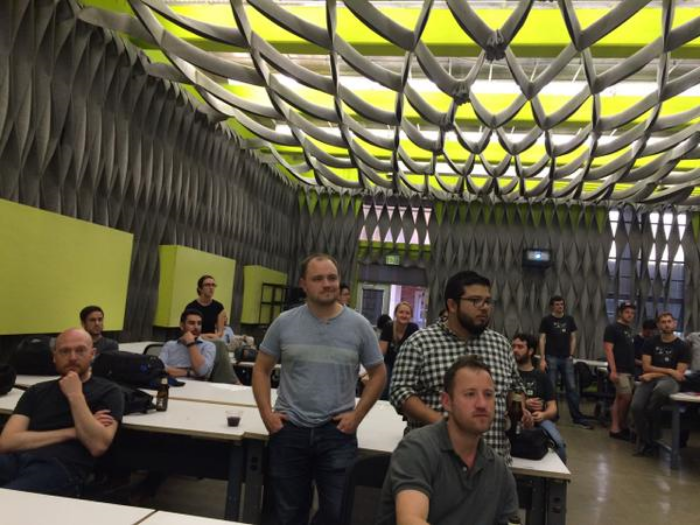by MIKE HRYMAK | July 2, 2015
Making one last domestic stop before heading to London this month, the popular AEC Hackathon road show rolled through sunny Southern California this past weekend.
Following what has now become a tried and true pattern, architects, engineers, project managers, coders, hackers, and tech trouble-shooters from several different firms all gathered at UCLA’s School of Architecture and Urban Design last Friday, June 26. They listened to the industry problems posed and then broke off into teams for 36-plus hours of intensive collaboration and creativity.

Attendees absorb knowledge as one team presents while the others learn. (Image c/o Dan Shirkey, Balfour Beatty)
By all accounts, the weekend was another smashing success. HOK‘s San Francisco-based firmwide design technologist, Brok Howard, said he had a blast. “If you are still on the fence about checking one out, do it!” he tweeted.
“I really enjoy the optimism and solution-oriented nature of these hackathons,” said Dan Shirkey, Balfour Beatty‘s San Diego-based technology COE leader. “Over these weekends, we see our industry’s many challenges as opportunities, and we try and solve them with very diverse teams.”
Newforma software engineer Chris Larson sang similar praises. “This was inspiring, fast-paced, and a lot of fun,” he said, noting that it was the second consecutive AEC Hackathon in which Newforma had taken home one of the top prizes. “You don’t need to be a developer or have much technical knowledge to participate,” he added. “All you need is an idea, a desire to invent, and a lot of coffee.”
“You don’t need to be a developer or have much technical knowledge to participate; all you need is an idea, a desire to invent, and a lot of coffee.”
After bouncing around a few ideas, Larson and his team committed to spending the weekend working on a reliable and easy-to-use facilities management system.
“Our final product was an open-source application that you can access on your smart phone, tablet, or the web,” he explained. “We defined three roles for our users: Reporters, who are able to create work orders by simply snapping a photo of the issue, add a description, and then selecting a location from a drop-down (menu) of registered locations. The incident then gets pushed to a Manager user who assigns its priority, sets an expected completion date, or assigns a worker to take care of the task. (Or) they can also close out the issue, marking it as resolved, or indicating that it won’t be fixed. A Worker user can to view tasks assigned and (see) the photo of the issue and its exact location.”
Larson’s group called itself “Team Holy Donut”, and won the Best Open Source Award. Below, a list of all the winners:
- Best Use of Experimental Tech: Team Cloud Tango & Team VRML (Virtual Review Management Loop)
- Best Open Source: Team Holy Donut
- Genesis Award (Sponsored by 2.2 Team Winner iPower): Team Agua Fresca
- Best Overall Project: Team Rhumbix
- BIMStorm Hack:
- Most Innovative Owner: Max, SPAWAR, DoD, Veteran Affairs
- Most Innovative Dev: Aditazz
- Best SEPS Design: Design Atlantic & Scarmack
- Best Connection: Attainia
- Best Hack of SEPS Data: 4D Pipeline
Best Use of Experimental Tech Co-Winner VRML created a program that allows a client to simply open a browser link from an email, connect a future commercially available Heads Up Display (HUD) like Oculus Rift, and see a virtual reality design. More information on VRML’s award-winning hack is available here.
Team Agua Fresca (Image c/o Jen Carlile, 2d from left)
Team Agua Fresca, winner of the Genesis Award, addressed the lack of a searchable database for water usage in buildings. Monica Cowan, an engineer at BuroHappold, said the team’s web app “allows a user to input water use data for a building in gallons per year, and based on square footage, it is assigned a water use intensity (WUI). This metric is then used to compare it against any other building type, size, and location in the database.” Along with Cowan, the team consisted of Flux cofounder Jen Carlile, software engineer Ali Raizin, and designer Jordan Manning, plus Kameron Burk from Jacobs.
Team Rhumbix also logged a big win in the Best Overall Project category with ‘The Gain App’ for job site safety. Founded by two U.S. Navy veterans, Rhumbix Inc. says it is built on the idea that “the worker’s safety and dignity come first.”
Next up for the AEC Hackathon? London is calling!
In less than two weeks, the catalytic collaborative event will be heading across the pond for the first time. Colleagues and competitors will gather from July 17-19 in London to tackle problems specific to the UK, where BIM will be mandated on all government work by next spring! Hackathon co-founders Damon Hernandez and Paul Doherty already are scheduled to speak at the ‘2.4‘event, as well as UK tech pioneer Paul Wilkinson, who will look ‘Beyond BIM’. Anyone interested in presenting at AEC Hackathon 2.4 in London should contact Hernandez or Doherty ASAP.
For more details on the SoCal winners and their hacks, click here, and visit Brok Howard’s recap.







Discussion
Be the first to leave a comment.
You must be a member of the BuiltWorlds community to join the discussion.